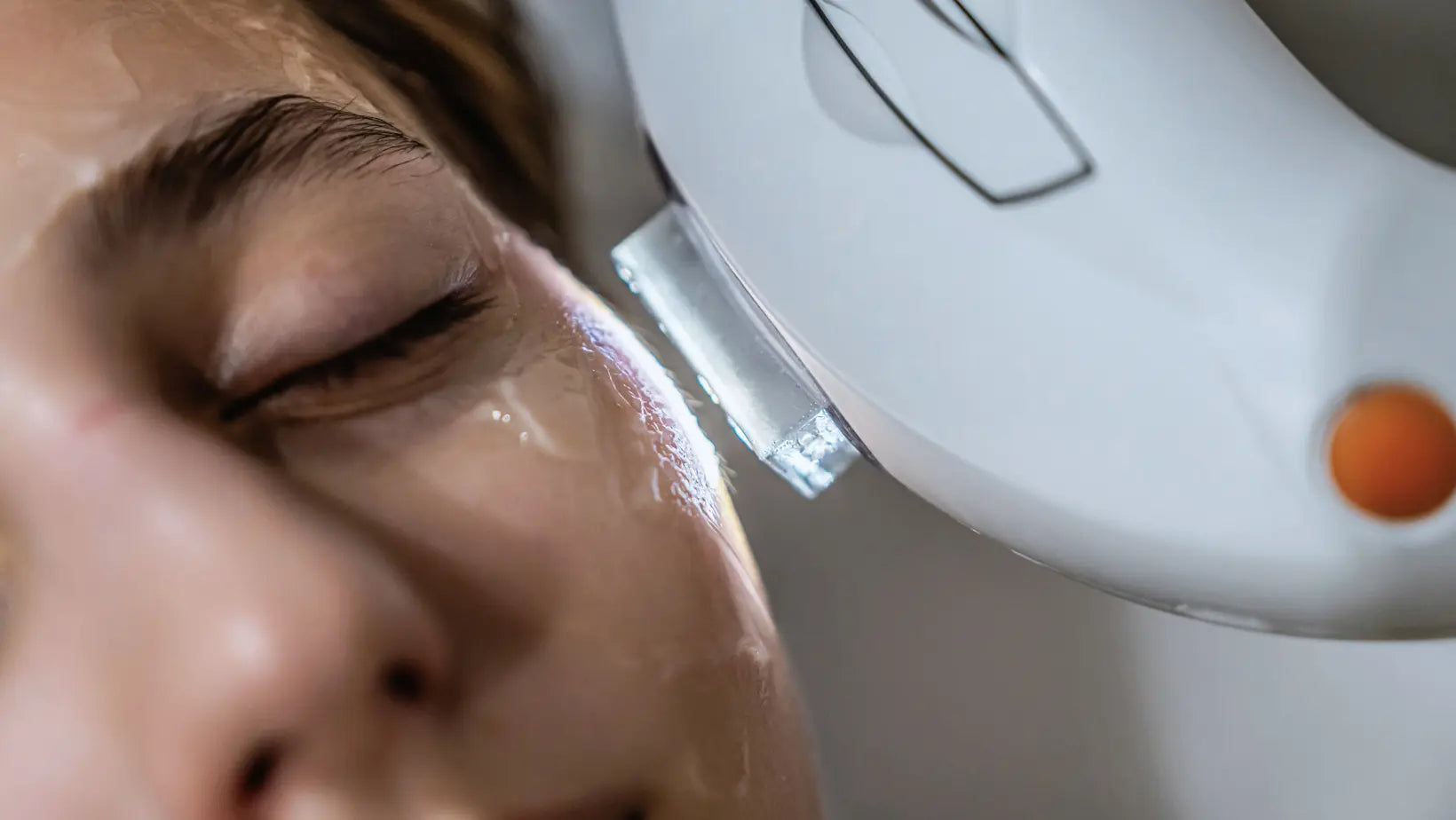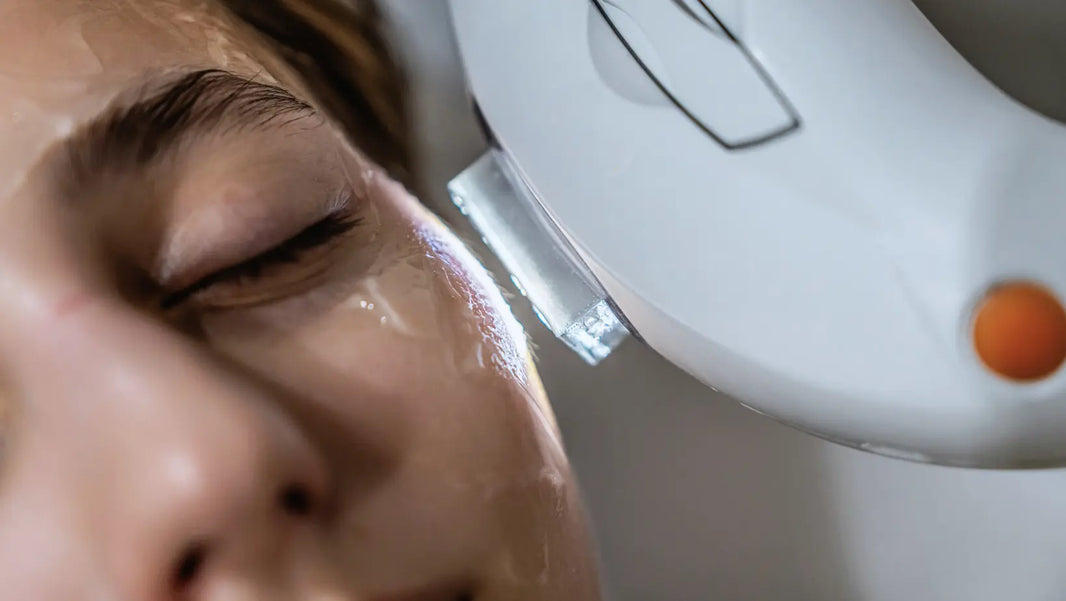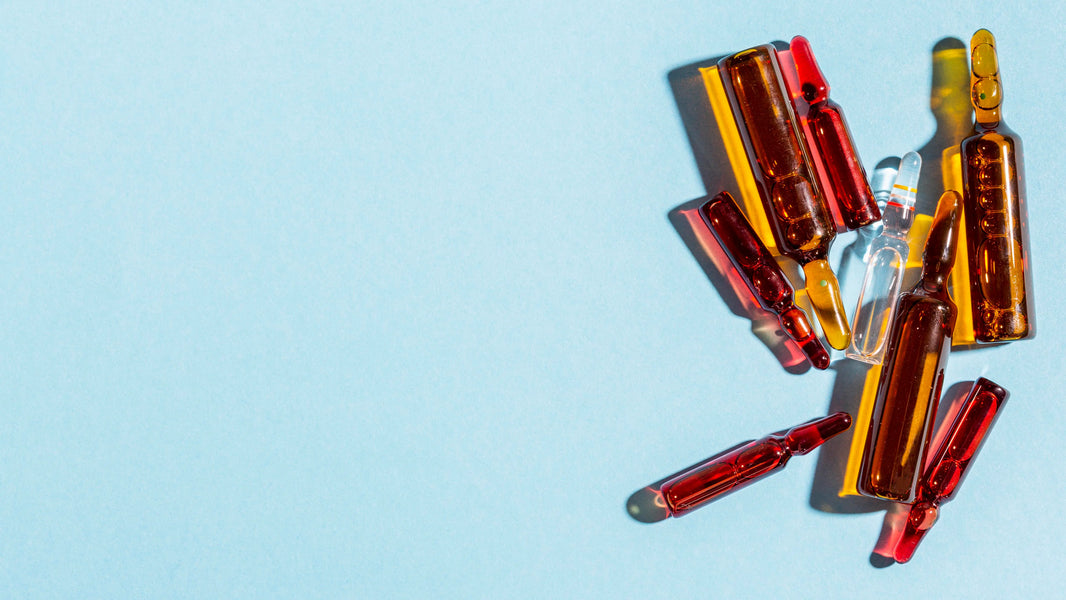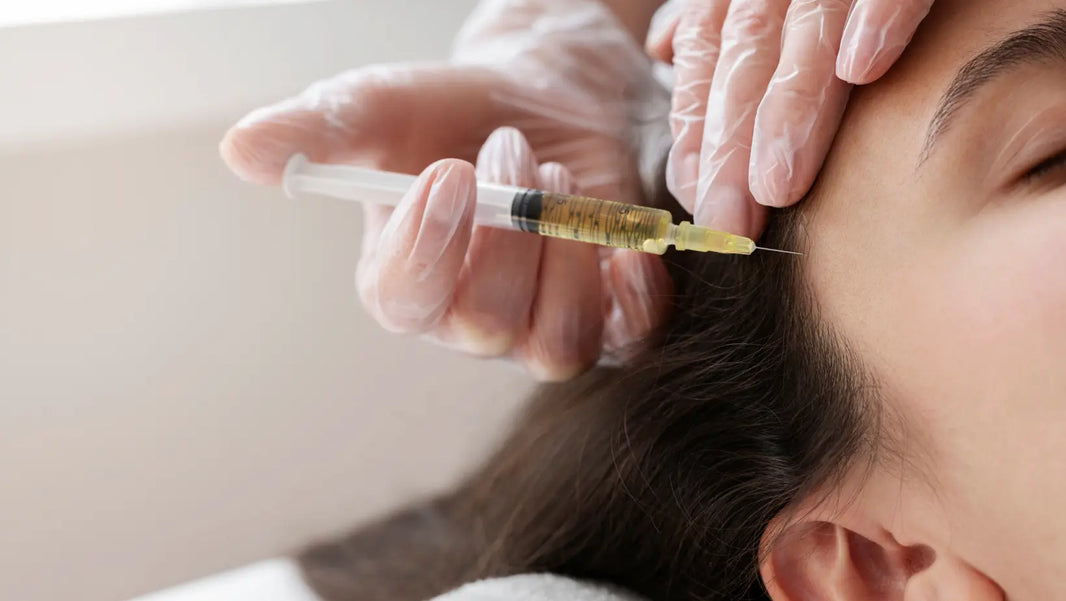Fraxel laser recovery is one of the most searched skincare topics for good reason. It promises smoother, younger-looking skin through advanced fractional technology, but the journey from treatment to results involves redness, peeling, and downtime that can feel intimidating if you don't know what to expect.
Understanding the science behind your skin's healing process can transform your recovery experience from anxious uncertainty to confident patience. This guide breaks down exactly what happens to your skin after a Fraxel session, how long recovery takes, and which evidence-based care strategies can help you heal beautifully and efficiently.
What you'll discover in this guide:
🔬 How Fraxel technology works on a cellular level
✨ The critical differences between non-ablative and CO₂ fractional treatments
📅 A day-by-day breakdown of what your skin will look like and feel like
⚠️ The most common aftercare mistakes that slow healing
💡 Dermatologist-approved strategies to support faster, safer recovery
Understanding Fraxel Laser Technology
Fraxel laser technology operates through a process called fractional photothermolysis, which creates thousands of microscopic thermal zones in your skin. Think of it as creating controlled micro-injuries that trigger your skin's natural healing response while leaving surrounding tissue intact to speed recovery.
Here's what makes this approach revolutionary:
The fractional advantage: Unlike older laser resurfacing methods that treated entire surface areas, Fraxel targets only a fraction of your skin at a time (typically 20-40% per session). This fractional approach means faster healing, lower complication risks, and the ability to treat delicate areas like under the eyes.
Cellular-level transformation: When the laser energy penetrates your skin, it activates fibroblasts - the specialized cells responsible for producing collagen and elastin. This triggers a cascade of regeneration that continues for months after your treatment, gradually improving texture, tone, fine lines, acne scars, and pigmentation irregularities.
The beauty of this technology lies in its precision. Each microscopic treatment zone (called a microthermal treatment zone or MTZ) extends through the epidermis into the dermis, initiating wound healing without damaging surrounding healthy tissue. This preserved tissue acts as a reservoir of cells that accelerate the healing process.
Source: PMC3229937
Types of Fraxel Lasers: What You Need to Know
Not all Fraxel treatments are created equal, and understanding the differences will help you set realistic recovery expectations.
|
Laser Type |
Wavelength |
Ablative? |
Primary Uses |
Typical Downtime |
|
Fraxel Dual 1550 |
1550nm |
No |
Acne scars, wrinkles, texture |
3-5 days |
|
Fraxel Dual 1927 |
1927nm |
No |
Pigmentation, melasma, sun damage |
2-4 days |
|
CO₂ Fractional |
10,600nm |
Yes |
Deep wrinkles, severe scarring |
7-14 days |
Non-ablative treatments (1550 and 1927) work by heating dermal tissue without removing skin. They target deeper layers to stimulate collagen remodeling while keeping the skin surface intact. Recovery is generally faster because your skin barrier remains continuous.
Ablative CO₂ fractional lasers actually vaporize microcolumns of tissue, removing small cylinders of skin from surface to depth. This creates more dramatic results for severe skin concerns but requires more extensive healing time and meticulous aftercare.
The key distinction: non-ablative Fraxel trains your skin to regenerate, while CO₂ fractional rebuilds it from the ground up.
Source: PMC5605208, PMC8570656
Is CO2 Laser and Fraxel Laser the Same Thing?
This is one of the most common points of confusion, so let's clear it up.
Fraxel is a brand name, much like Kleenex is to tissues. The term has become somewhat synonymous with fractional laser treatments, but technically, Fraxel refers to specific devices manufactured by Lumenis and now Candela. Some Fraxel devices deliver CO₂ laser energy in a fractional pattern, while others (like Fraxel Dual) use non-ablative wavelengths.
Here's the breakdown:
➡️ CO₂ lasers refer to any laser that uses carbon dioxide as the active medium, producing a 10,600nm wavelength that vaporizes tissue
➡️ Fraxel can be either non-ablative (like the 1550/1927 systems) OR ablative (CO₂ fractional)
➡️ Not all fractional CO₂ lasers are Fraxel-branded, and not all Fraxel treatments use CO₂ technology
Think of it this way: all Fraxel CO₂ treatments are fractional CO₂ lasers, but not all fractional CO₂ lasers are Fraxel. The brand matters less than understanding whether your specific treatment is ablative or non-ablative, as this dramatically affects your recovery timeline and aftercare needs.
Source: PMC8570656
What to Expect After Fraxel Laser Treatment?
The immediate aftermath of Fraxel treatment can feel intense, but understanding what's normal helps you navigate recovery with confidence.
Within the first few hours:
Your skin will feel warm and tight, similar to moderate sunburn. Redness is universal and expected - this is your skin's inflammatory response activating the healing cascade. Some patients experience mild swelling, especially around the eyes and cheeks where skin is thinner.
The first 24-48 hours:
Redness intensifies and you may notice a "bronzed" or darkened appearance as treated areas oxidize. This bronzing is actually a positive sign - it represents the microscopic epidermal necrotic debris (MEND) that will eventually peel away, revealing fresh skin beneath. Your skin may feel rough or sandpaper-like to the touch.
Days 3-5:
Peeling begins, typically starting around the mouth, nose, and forehead. This isn't like a sunburn peel - it's finer, almost like dry skin flaking. Some patients experience minimal visible peeling while others shed more noticeably. Both responses are normal and depend on your individual healing biology and the treatment intensity.
Week 2 and beyond:
Redness gradually fades to pink, then resolves completely. Your skin may feel slightly sensitive but should return to normal texture. The real magic happens beneath the surface over the next 3-6 months as collagen remodeling continues.
These visible changes represent your skin's remarkable healing capacity in action. The inflammatory phase, proliferation of new cells, and tissue remodeling all work in concert to resurface and rejuvenate your skin from within.
Source: PMC8971160, PMC3229937
CO2 Fraxel Laser Recovery
Ablative CO₂ fractional treatments demand more patience and diligence than their non-ablative counterparts, but the tradeoff is more dramatic improvement for severe skin concerns.
The extended timeline:
🔴 Redness: 5-14 days of significant erythema, potentially longer for sensitive individuals
⚪ Crusting/weeping: Peaks around days 4-5 as the epidermis regenerates
🟡 Post-inflammatory erythema: Can persist 2-3 weeks or more
Because ablative lasers remove portions of the epidermis, your skin barrier is temporarily compromised. This makes you more vulnerable to infection, hyperpigmentation, and prolonged healing if aftercare isn't meticulous.
Critical considerations for CO₂ recovery:
Moist wound healing becomes essential. Unlike non-ablative treatments where your skin barrier remains intact, CO₂ creates actual wounds that must be kept hydrated to heal optimally. Dryness can lead to excessive scabbing, which increases scarring risk and extends downtime.
Sun avoidance isn't negotiable. Your newly resurfaced skin has zero natural protection for several weeks. Even brief unprotected exposure can trigger post-inflammatory hyperpigmentation (PIH) that may take months to fade.
The depth of treatment matters significantly. Aggressive CO₂ settings that penetrate deeper deliver more dramatic results but require correspondingly longer healing periods. Your provider should calibrate treatment intensity to balance your goals with realistic recovery constraints.
Source: PMC5605208
Fraxel Laser Recovery Process
Understanding the biological phases of healing helps you recognize what's happening beneath the surface and why patience pays off.
Phase 1: Inflammatory Response (Days 1-3)
Your immune system immediately recognizes the microscopic thermal injuries and floods the area with inflammatory mediators. This causes the characteristic redness, warmth, and mild swelling. While it may look alarming, inflammation is essential - it clears damaged cells and signals repair mechanisms to activate.
Phase 2: Proliferation (Days 3-7)
New cell production accelerates dramatically. Keratinocytes (skin cells) multiply and migrate to close the microscopic wounds. Fibroblasts begin synthesizing fresh collagen and elastic fibers. This is when you'll see peeling as old, damaged cells shed to make room for new tissue.
Phase 3: Remodeling (Weeks 2-12+)
The longest and most important phase happens mostly invisibly. Collagen fibers mature and reorganize, gradually improving skin texture, firmness, and tone. This is why Fraxel results continue improving for 3-6 months post-treatment - the remodeling process is slow but profound.
Scientific studies show that epidermal barrier function typically returns within 24-48 hours after non-ablative treatments, though visible redness persists longer as deeper dermal remodeling continues. With ablative treatments, complete barrier restoration takes 7-14 days.
Source: PMC8570656, PMC3229937

Fraxel Laser Recovery Day by Day
Here's what you can realistically expect as your skin heals:
|
Day |
What's Happening |
Your Action Plan |
|
1 |
Intense redness, heat sensation, possible swelling |
Cool compresses (15 min every 2 hours), gentle cleanser, avoid touching |
|
2-3 |
Dryness, tightness, bronzing appearance emerges |
Gentle hydration with barrier-repair serums, no makeup yet |
|
4-5 |
Peeling begins (fine flaking or larger sheets) |
DO NOT PICK! Keep moisturized, let skin shed naturally |
|
6-7 |
Redness fading, texture smoothing |
Resume SPF 50+, can begin lightweight makeup if needed |
|
8-14 |
Pink tone resolving, fresh glow emerging |
Gradually reintroduce gentle active ingredients if cleared by provider |
|
14-30 |
Continued improvement, subtle texture refinement |
Maintain sun protection, consider supportive serums to enhance results |
Pro tip for days 3-5: The urge to peel flaking skin is overwhelming, but resist! Premature removal can disrupt the healing epidermis beneath, potentially causing hyperpigmentation or delayed healing. Instead, keep skin well-moisturized so flakes soften and detach naturally.
Supporting cellular recovery: During the critical first week when cell turnover is at its peak, using advanced serums can complement your skin's natural healing process. Products containing growth factors or cellular signaling molecules may help support the regeneration cascade your skin is already orchestrating. For instance, exosome-based serums work at the cellular communication level to potentially support faster visible recovery and skin quality improvements.
Source: PMC8570656
What Not to Do After Fraxel Laser
Avoiding these common mistakes can be the difference between optimal healing and prolonged complications.
❌ Heat Exposure (Days 1-3)
No hot showers, saunas, steam rooms, or intense workouts. Heat increases blood flow to already inflamed tissue, intensifying swelling and redness. It can also increase the risk of hyperpigmentation in healing skin.
❌ Active Skincare Ingredients (Days 1-10)
Skip retinoids, AHAs, BHAs, vitamin C serums, and any exfoliants. Your skin is already in maximum exfoliation mode - adding chemical exfoliants can cause irritation, barrier damage, and prolonged healing. Wait until redness completely resolves and get provider clearance before reintroducing actives.
❌ Sun Exposure Without Protection
This cannot be overstated: your treated skin is exceptionally photosensitive for weeks after Fraxel. Even incidental sun exposure (walking to your car, sitting near a window) can trigger PIH. Use SPF 50+ mineral sunscreen daily and reapply every 2 hours when outdoors. Wear a wide-brimmed hat for added protection.
❌ Picking, Scrubbing, or Manual Exfoliation
The peeling process should be entirely passive on your part. Picking at flaking skin removes the protective layer before underlying cells are ready, exposing raw tissue that's vulnerable to infection and scarring. Similarly, avoid washcloths, scrubs, or any mechanical friction.
❌ Makeup Too Soon
While mineral makeup can typically be worn after 48 hours for non-ablative treatments, liquid foundations and heavy coverage can trap heat and bacteria against healing skin. If you must wear makeup, choose mineral powder formulations and apply with clean brushes. For ablative CO₂ treatments, wait until all crusting has resolved (typically 7-10 days).
Improper aftercare is the leading cause of complications like post-inflammatory hyperpigmentation, prolonged erythema, and even infection. Following these guidelines protects your investment and your results.
Source: PMC8971160
Fraxel Laser Healing Time
The honest answer is: it depends on multiple intersecting factors.
Treatment type matters most:
→ Non-ablative Fraxel (1550/1927): Social downtime averages 3-5 days, though redness may persist 7-10 days
→ Ablative CO₂ fractional: Expect 7-14 days of significant downtime, with residual pinkness lasting 2-4 weeks or longer
Skin type influences healing speed:
Individuals with darker skin tones (Fitzpatrick types IV-VI) often experience prolonged post-inflammatory erythema. This doesn't mean healing is slower, but visible redness resolves more gradually. These patients are also at higher risk for PIH, making sun protection and gentle aftercare even more critical.
Treatment intensity scales with results and recovery:
Conservative settings (lower energy, fewer passes) heal faster but require multiple treatment sessions for optimal results. Aggressive single-session treatments deliver more dramatic improvement but demand longer recovery. Your provider should help you balance these tradeoffs based on your goals and lifestyle constraints.
Aftercare compliance is everything:
Two patients receiving identical treatments can have vastly different healing experiences based solely on how well they follow aftercare protocols. Consistent moisturization, sun avoidance, and gentle handling can shorten visible downtime by several days.
The visible healing represents only the beginning. True collagen remodeling continues for 3-6 months after treatment, meaning your results will continue improving long after redness resolves. This is why providers often space Fraxel sessions 4-6 weeks apart - to allow adequate time for full tissue remodeling before the next treatment.
Source: PMC3229937, PMC5605208
Fraxel Laser Recovery Tips
These evidence-based strategies can optimize your healing and enhance your results.
✅ Hydrate Relentlessly
Keep treated skin continuously moisturized with gentle, non-comedogenic serums and creams. Well-hydrated skin heals faster because moisture supports cell migration and prevents excessive transepidermal water loss. Look for ingredients like hyaluronic acid, ceramides, and peptides that support barrier repair.
✅ Elevate While Sleeping (Days 1-3)
Sleep with your head elevated on 2-3 pillows to minimize facial swelling, especially if you've had under-eye treatment. Gravity is your friend in reducing fluid accumulation.
✅ Mineral Sunscreen is Non-Negotiable
Use zinc oxide or titanium dioxide-based SPF 50+ daily, even if you're staying indoors. UV exposure is the single greatest risk factor for PIH after laser treatment. Reapply every 2 hours when exposed to sunlight.
✅ Consider Growth Factor Support
Your skin is in peak regeneration mode during the first 7-10 days. This is an ideal window to incorporate serums that support cellular repair mechanisms. Advanced formulations containing exosomes or growth factors work at the cellular signaling level to potentially enhance your natural healing cascade.
✅ Gentle Cleansing Only
Use a mild, pH-balanced cleanser without sulfates or fragrance. Pat (don't rub) your face dry with a clean, soft towel. Avoid micellar waters that require wiping - any friction can irritate healing skin.
✅ Stay Hydrated Internally
Drink plenty of water and eat nutrient-rich foods that support skin healing - foods high in vitamin C, zinc, and omega-3 fatty acids can support your body's repair processes from the inside out.
❌ Don't Mix Active Ingredients Too Soon
The temptation to "boost" results with retinoids or acids is strong, but premature reintroduction causes irritation and can actually slow healing. Wait at least 10-14 days and get provider clearance before resuming active skincare.
❌ Never Skip Sunscreen
This bears repeating because it's so critical. Your fresh, healing skin has essentially zero natural UV protection. Every unprotected sun exposure creates cumulative damage and PIH risk that can take months to reverse.
Source: PMC12104010, PMC8971160
Fraxel Laser Under Eye Recovery
The periorbital area deserves special attention due to its unique anatomy and slower healing characteristics.
Why under-eye healing takes longer:
The skin around your eyes is the thinnest on your body - roughly 0.5mm compared to 2mm on your cheeks. This delicate tissue has fewer sebaceous glands, less collagen density, and more vascular networks. These factors combine to create more pronounced swelling and slower visible healing.
What to expect:
🔹 Swelling: Peaks 24-48 hours after treatment and can persist 3-5 days
🔹 Bruising: Occasional but possible, especially if you take blood thinners or supplements like fish oil
🔹 Sensitivity: The area may feel tender or tight for up to a week
Specialized care tips:
Cool compresses work exceptionally well for periorbital swelling. Apply for 10-15 minutes every 2-3 hours during the first 48 hours. Use gentle pressure - never press firmly on healing tissue.
Avoid rubbing or pulling when cleansing. The instinct to rub tired eyes is strong, but any friction can disrupt healing and potentially cause hyperpigmentation. Pat the area dry with a soft cloth.
No eye makeup for at least 3-5 days. Mascara, eyeliner, and eyeshadow can introduce bacteria to compromised tissue and may require rubbing to remove. When you do resume makeup, use fresh products and clean applicators.
Skip retinoids and active eye creams until redness fully resolves (typically 10-14 days). The periorbital area is highly reactive, and premature active use can cause persistent irritation.
If you experience spreading redness, increasing pain, or discharge, contact your provider immediately. While rare, infections can occur and require prompt treatment.
Source: PMC5605208
What Could Go Wrong After Fraxel Laser?
While Fraxel is generally safe when performed by experienced providers with proper aftercare, complications can occur. Understanding warning signs helps you act quickly if something seems wrong.
Post-Inflammatory Hyperpigmentation (PIH)
This is the most common complication, particularly in individuals with darker skin tones. PIH appears as darkened patches in treated areas and results from melanocyte hyperactivity triggered by inflammation. Sun exposure is the primary risk factor, which is why sun protection is so critical during healing.
Prevention: Strict sun avoidance, consistent SPF 50+ application, and following all post-care instructions
Treatment: If PIH develops, your provider may recommend topical lightening agents, gentle chemical peels, or additional laser treatments once skin is fully healed
Prolonged Erythema
Some patients experience persistent redness lasting weeks or months beyond typical healing times. This can result from overly aggressive treatment settings, individual skin sensitivity, or inadequate post-treatment care.
Red flags: Redness that worsens after the first week or doesn't show gradual improvement
Infection
Though rare when proper hygiene is maintained, bacterial or viral infections can develop in compromised skin. Herpes simplex virus (cold sores) can be triggered by facial laser treatments in susceptible individuals.
Warning signs: Increasing pain, spreading redness, oozing, pustules, or fever
Prevention: Some providers prescribe prophylactic antivirals for patients with cold sore history
Scarring
Extremely rare with modern fractional devices, but possible if treatment settings are too aggressive, the laser is held too long in one area, or if patients pick at healing skin.
Prevention: Choose an experienced, certified provider and never manually remove peeling skin
Contact Dermatitis
Allergic reactions to post-treatment products can complicate healing. Stick with simple, fragrance-free, hypoallergenic products during recovery.
When to call your provider immediately:
⚠️ Pain that worsens after day 3
⚠️ Spreading redness or warmth
⚠️ Oozing, crusting, or pustules
⚠️ Fever or flu-like symptoms
⚠️ Blistering beyond expected pinpoint areas
Most complications are preventable with proper patient selection, appropriate treatment parameters, and diligent aftercare. Your provider should assess your skin type, medical history, and risk factors before treatment to minimize complication potential.
Source: PMC8971160, PMC5605208
FAQ
How long is recovery from Fraxel laser?
Recovery time depends primarily on whether you receive ablative or non-ablative treatment. Non-ablative Fraxel (wavelengths 1550 and 1927) typically requires 3-5 days of social downtime, with redness potentially lasting 7-10 days. Ablative CO₂ fractional lasers demand more extensive healing: 7-14 days of significant downtime with residual pinkness persisting 2-4 weeks or longer. However, deeper collagen remodeling continues for 3-6 months post-treatment, which is when you'll see maximum results.
What not to do after Fraxel laser?
The most critical things to avoid are heat exposure, sun without SPF 50+ protection, active skincare ingredients (retinoids, acids, vitamin C), and picking at peeling skin. For the first 3 days, skip hot showers, saunas, steam rooms, and intense workouts, as heat exacerbates swelling and redness. Avoid all exfoliating products and active ingredients for 7-10 days - your skin is already in maximum regeneration mode and additional exfoliation will cause irritation.
What do you look like immediately after Fraxel?
Immediately after treatment, your skin will appear quite red - similar to moderate sunburn. This redness is accompanied by warmth and a tight feeling. Some patients experience mild swelling, particularly around the eyes and on the cheeks. Within hours, you may notice a "bronzed" or slightly darkened appearance as treated areas oxidize. Your skin might feel rough or sandpaper-like to the touch.
What is the best aftercare for Fraxel laser?
The most effective aftercare strategy combines consistent hydration, rigorous sun protection, and gentle handling. Keep treated skin continuously moisturized with barrier-supporting ingredients like ceramides, hyaluronic acid, and peptides. Apply mineral-based SPF 50+ sunscreen every 2 hours during sun exposure - this is non-negotiable for preventing hyperpigmentation.
How do you speed up healing after fractional laser?
While you can't rush the biological healing timeline, you can create optimal conditions for efficient recovery. Keep skin consistently hydrated - well-moisturized tissue heals faster because moisture supports cell migration and prevents transepidermal water loss. Use barrier-repair ingredients like ceramides and hyaluronic acid.
Protect healing skin from UV exposure absolutely, as sun damage disrupts the remodeling process and triggers inflammation. Get adequate sleep and maintain good overall nutrition - your body needs resources to build new collagen and skin tissue.
Final Thoughts on Fraxel Recovery
Fraxel laser recovery is a short-term investment that yields long-term transformation when managed with care, patience, and evidence-based aftercare. Your skin is remarkably resilient and capable of profound regeneration - the redness, peeling, and temporary discomfort represent powerful healing forces at work beneath the surface.
The journey from treatment day to final results spans months, not days. While visible downtime may last 3-14 days depending on your treatment type, the real magic unfolds gradually as collagen matures and tissue remodels. This is why some patients see continued improvement 4-6 months post-treatment.
Three principles define successful Fraxel recovery:
Patience: Trust the biological timeline. Your skin cannot be rushed, but it can be supported
Protection: Sun exposure is your greatest risk factor - make SPF your closest companion
Gentleness: Less is more during healing. Simple, minimal skincare outperforms aggressive interventions
Your provider's specific aftercare instructions should always take precedence over general guidelines. They've calibrated your treatment to your unique skin and know exactly what your tissue needs for optimal healing.
With thoughtful care, gentle hydration, and unwavering sun protection, your skin will heal efficiently and reveal the smoother, more radiant complexion you're working toward. Every day brings you closer to the results you're seeking - and those results will continue improving long after redness fades.
Celebrate each stage of renewal. Your skin is doing exactly what it's designed to do: regenerate, repair, and emerge more beautiful than before.
References:
- PMC3229937 - Fractional laser skin rejuvenation overview
- PMC5605208 - Fractional laser technology and clinical applications
- PMC8570656 - Fractional laser principles and histology
- PMC8971160 - Post-laser skin care and complications
- PMC12104010 - Advanced wound healing and recovery optimization
- Pubmed 39977363 - Recent developments in fractional laser therapy





